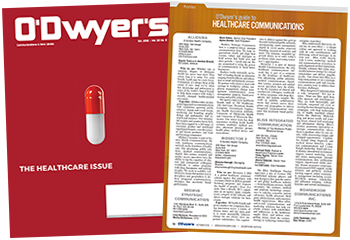 Jon Watson |
Perhaps unsurprisingly, clients are demanding greater levels of creativity from their PR agency every year. This goes hand-in-hand with a steady increase in clients’ “receptiveness” to creative ideas to solve their problems.
There is both a demand and an appetite for “creative.”
In response to this, there’s been a corresponding investment in creative talent in our industry. Many leading PR firms now have a creative director and have acquired advertising agencies to assimilate their creative departments into the integrated communications agency model.
Problem solved? Sadly not. The creative needle has hardly moved.
It raises two interesting questions: What is “creativity?” and whose job is it to spirit it up from nowhere?
To the question “What is creativity?” the glib answer is “It depends on who you ask.” It’s almost impossible to quantify (although an entire industry exists to try!). Whenever someone asks me this question, I reply, “generosity.” Creativity should give you something; it should leave you richer in some way than before. It should provoke, reward, enrich, inform, inspire. And you should be ever so slightly altered having experienced it. It should create movement. Ideally, meaningful change.
And to the question, “whose job is it?” the solution doesn’t stop at “the creative director.”
Simply appointing someone as “creative” isn’t enough to develop work that moves hearts and minds, that drives this meaningful change. It’s certainly a good start, but it requires a cultural shift from within — across the entire organization. For creativity (in both ideas and our people) to thrive, we need to nurture an environment that allows it to grow. An individual can’t do it in isolation.
Some organizations haven’t fully grasped this. Perhaps this is why the exodus frequency of these new creative champions almost matches the number of triumphant arrivals.
First and foremost, we must recognize that all humans are hardwired to create while organizations are not. We must celebrate being human in all its imperfect glory and encourage people to be their authentic selves. We need time to think, to make mistakes, to learn and develop, to improve and perfect. That’s how creative works. There’s risk attached.
This is alien to historically risk-averse businesses. Failure is bad. Bad for reputation. Bad for business. But as one of the world’s most successful engineers, Soichiro Honda, rightly highlights, success is 99 percent failure. If you don’t allow yourself to fail, you’ll always end up doing the same old tried-and-trusted tactics. Nobody will fire you for it. They won’t thank you (they won’t remember you either). Many agencies rate their own work “ordinary” and rarely rate it “inspirational.” Ouch.
That’s the tough one to get your arms around. But Honda was so right.
Second, we should focus on the creative experience that our entire team has in working at the agency, as well as the experience that our clients have in being our partners. Creative thinking should always be at the core of the business. All too often, it’s just bolted on at the end. And it shows.
If every aspect of your business has a creative beginning, it will stand a far higher chance of having a creative end. How you interact with your clients, how you generate insight, how you convert this to a strategy, how you interact with the other members of the organization. Do that, and the creative is a seamless extension of your solution — not a retro-fitted interpretation. By being committed to the highest quality of creative thinking, making it easy to do business with us, and making good use of people’s time, we make it worth it for everyone.
This process highlights a final point. If the work isn’t relevant, it simply won’t work. It has no generosity to give. This is why insight is such a critical component to unlocking creativity. We observe critical biases and hypotheses to uncover deeper, unspoken truths about our stakeholders, the commercial and cultural landscapes, and the scientific foundations of medications and health conditions. And we have a variety of stakeholders to consider — from the media, to patients, caregivers, advocates, HCPs, payers and policymakers — all have different perspectives and priorities. True insight comes from curiosity and letting go of assumptions. There are countless tools and techniques. It takes rigor to go deep and relentless questioning to unearth a meaningful insight that can lead to a transformative strategy that promotes and inspires great creative.
At Health Unlimited, our purpose is to create meaningful change in health, and we’re committed to solving the world’s most complex and challenging health issues. We apply these creative principles to solve client problems as we help them advance landmark developments in health and deliver results.
With words like “complex” and “challenging,” the creative has to be up to the task. It has to be meaningful and it has to reward a person’s involvement. That rarely happens straight out of the box. But that’s okay. And Soichiro Honda would agree with us.
***
Jon Watson is global executive creative director of Health Unlimited, a global health consultancy and communications agency.



 Lo Isidro, senior director at Real Chemistry with more than a decade of strategic communications and PA experience, has joined Narrative Strategies.
Lo Isidro, senior director at Real Chemistry with more than a decade of strategic communications and PA experience, has joined Narrative Strategies. Nelson Fernandez, former North American chair of APCO Worldwide and managing director of Burson-Marsteller, has joined Volunteers in Medicine Berkshires as director of communications and PA.
Nelson Fernandez, former North American chair of APCO Worldwide and managing director of Burson-Marsteller, has joined Volunteers in Medicine Berkshires as director of communications and PA. Lilit Bargar, who was most recently an EVP in the healthcare practice at Weber Shandwick, comes on board at GCI Health as EVP, corporate practice lead.
Lilit Bargar, who was most recently an EVP in the healthcare practice at Weber Shandwick, comes on board at GCI Health as EVP, corporate practice lead.
 Five ways that successful thought leaders are made.
Five ways that successful thought leaders are made.


 Have a comment? Send it to
Have a comment? Send it to 
No comments have been submitted for this story yet.